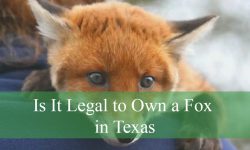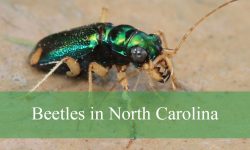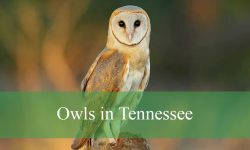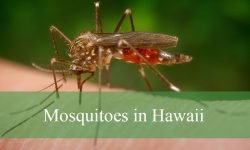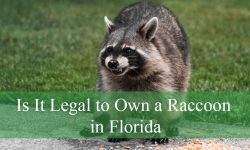Florida’s beaches, mudflats, and wetlands are home to a fascinating variety of plovers—small, agile shorebirds that capture the hearts of birdwatchers with their quick movements, short bills, and gentle mannerisms. These charming birds can often be seen darting along the tide line, stopping suddenly to peck at tiny crustaceans or insects. Their presence adds life and character to Florida’s coastal landscapes, making them a favorite among photographers and nature enthusiasts alike.
From year-round residents like the Wilson’s Plover to migratory visitors such as the Semipalmated Plover, Florida offers one of the richest opportunities in the United States to observe these shorebirds throughout the year. Each species has its own unique charm, habitat preferences, and behaviors that make them special. Below are 10 types of plovers found in Florida, described in detail to help you recognize and appreciate them in their natural environments.
Types of Plovers Found in Florida
Wilson’s Plover (Charadrius wilsonia)
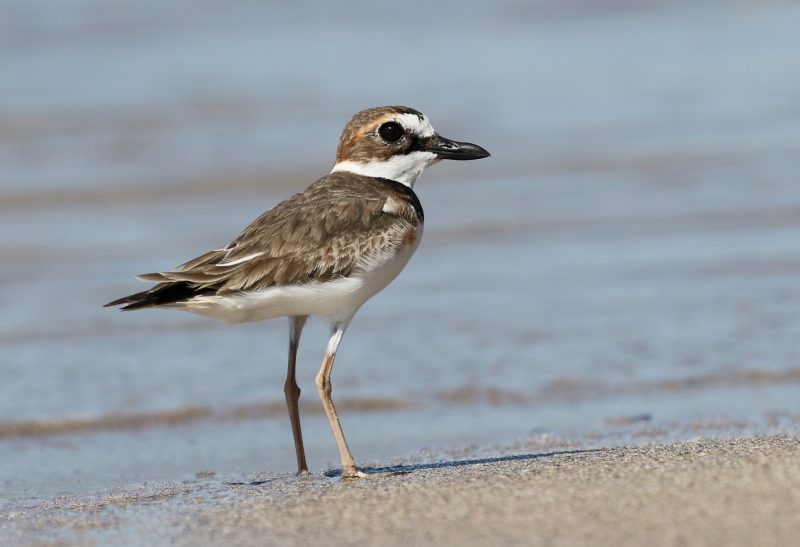
The Wilson’s Plover is a year-round resident along Florida’s extensive coastline, often seen patrolling sandy beaches, tidal flats, and salt pans. Medium-sized for a plover, it measures about 7 to 8 inches (18–20 cm) in length with a wingspan of around 18 inches (46 cm). It has a thick, heavy black bill—distinctively larger than that of most other plovers—along with sandy brown upperparts and a clean white underside. A single dark breast band marks its chest, which appears darker and more pronounced in males during the breeding season. Females are slightly lighter, with more muted tones.
This species primarily feeds on small crustaceans such as fiddler crabs, which it captures with precision along the shoreline. Its hunting behavior is characteristic: a series of quick runs followed by sudden stops to grab prey from the wet sand. Wilson’s Plovers also eat insects, marine worms, and other invertebrates found near the tide line. Their short bursts of movement and watchful stance make them a joy to observe for anyone visiting Florida’s beaches.
During the breeding season, Wilson’s Plovers nest on open sandy ground just above the high-tide line, scraping shallow depressions in the sand to lay their eggs. Because of their preference for exposed nesting sites, their eggs and chicks are highly vulnerable to disturbance from human activity, predators, and pets. Conservation efforts—including restricted beach zones and awareness programs—play a crucial role in protecting their fragile populations.
In Florida, Wilson’s Plovers are widespread and can be found along both the Atlantic and Gulf coasts. They are especially abundant in the Gulf Islands National Seashore, Cape Sable, and throughout the Florida Keys, where undisturbed shorelines provide ideal nesting and feeding grounds.
Snowy Plover (Charadrius nivosus)
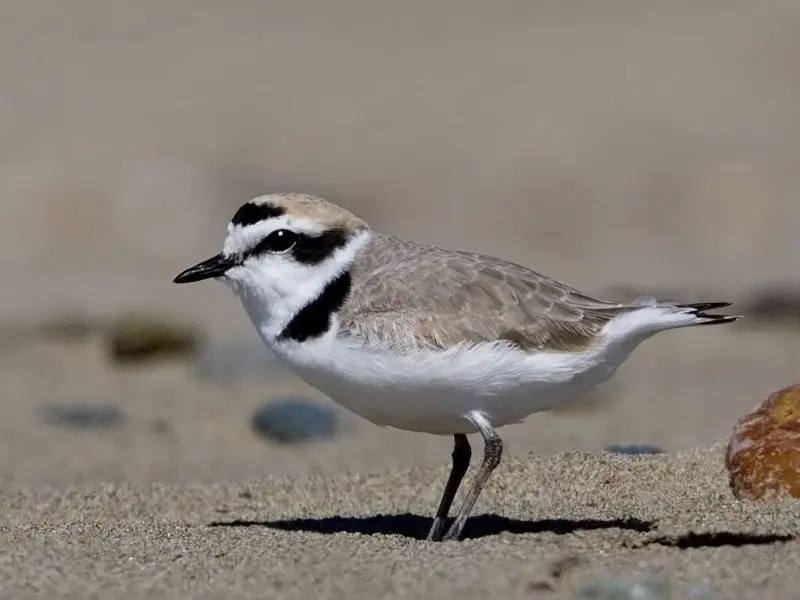
The delicate Snowy Plover is one of Florida’s most enchanting yet vulnerable beach-nesting birds. Tiny and pale, it blends almost invisibly with the coastal sands. Adults measure about 5.9 to 6.7 inches (15–17 cm) long, with a wingspan of around 13 inches (33 cm) and weigh only about 1.5 ounces (43 g). Their upperparts are light gray, while their undersides are pure white. Small dark ear patches and narrow black markings on the head give them a subtle but charming appearance that perfectly suits their beach environment.
Snowy Plovers feed on small insects, marine worms, and crustaceans, which they pick from the surface of the sand. Their foraging technique is quick and energetic—they sprint a few steps, stop abruptly, and then snatch prey from the sand or wrack line. They usually feed during the early morning and late afternoon to avoid the hottest hours of the day. These birds prefer sparsely vegetated sandy beaches and salt flats, where their pale plumage provides excellent camouflage from predators.
In Florida, the Snowy Plover nests primarily along the Gulf Coast, from Franklin County down to Collier County. Breeding occurs from February through August, with nests made as shallow scrapes in the sand, often near dune vegetation. Unfortunately, their choice of nesting areas overlaps with popular recreation sites, making them highly susceptible to human disturbance and predation. As a result, the Snowy Plover is listed as Threatened in Florida. Protected zones and beach management programs play a vital role in their conservation.
Spotting a Snowy Plover requires patience and keen observation. Their sand-colored plumage allows them to virtually disappear into their surroundings, and they rely heavily on this camouflage to avoid predators such as gulls, raccoons, and even unleashed dogs. Observing them from a respectful distance helps ensure that these fragile coastal residents continue to thrive on Florida’s shores.
Piping Plover (Charadrius melodus)
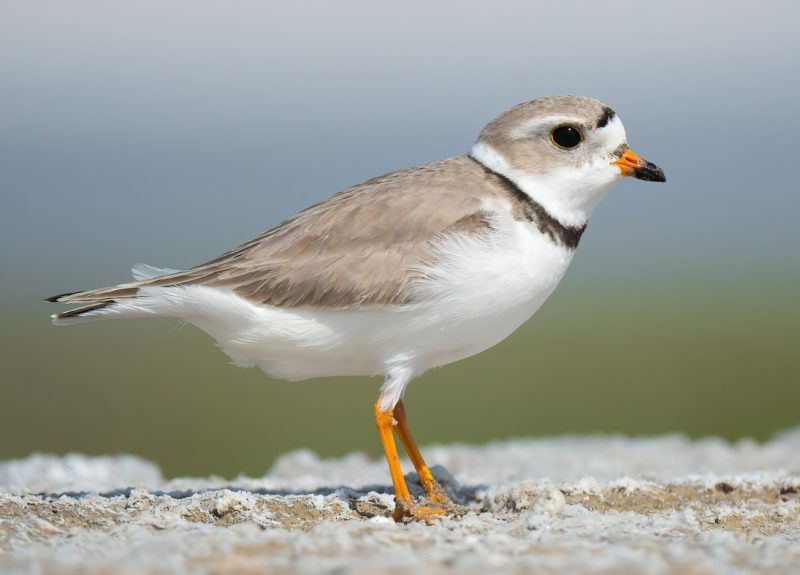
The Piping Plover is a small, round-bodied shorebird that captivates birdwatchers with its gentle appearance and soft, musical call. Measuring about 6.7 to 7 inches (17–18 cm) in length with a wingspan of 14 inches (35 cm), it has pale gray upperparts, white underparts, and a distinctive black band across the forehead and neck during the breeding season. Its short orange bill tipped with black and bright orange legs make it easily recognizable on sandy beaches.
These plovers are winter visitors to Florida, where they frequent open beaches, tidal flats, and coastal lagoons. They forage by sight, probing soft sand and mud for small marine worms, crustaceans, and insects. Their feeding movements are methodical—short runs followed by quick stops as they pick up prey. They are often seen alone or in small groups, blending well with their surroundings thanks to their pale coloration.
The Piping Plover is federally listed as a Threatened species due to habitat loss and human disturbance in both breeding and wintering areas. Florida provides crucial wintering grounds for birds that breed as far away as the Great Lakes, the Atlantic Coast, and the Northern Great Plains. Conservation programs monitor their non-breeding populations closely, ensuring suitable resting and foraging conditions are maintained.
In Florida, Piping Plovers are most commonly observed along the Gulf Coast, especially at Fort De Soto Park, St. George Island, and Anclote Key Preserve State Park. Their soft “peep-lo” call often gives them away before they are seen—a gentle reminder of the fragile beauty they bring to Florida’s winter shores.
Semipalmated Plover (Charadrius semipalmatus)
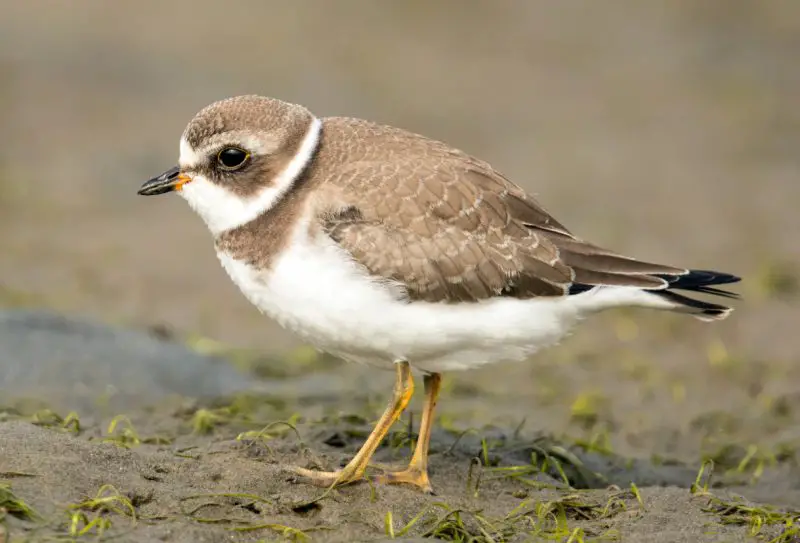
The Semipalmated Plover is one of the most common and widespread plovers found in Florida, particularly during migration periods. Small and compact, it measures about 6.7 to 7.5 inches (17–19 cm) long with a wingspan of 14 to 15 inches (35–38 cm) and weighs around 1.9 ounces (55 g). It has a short, dark bill tipped with orange at the base, a brown back, a white underside, and a single bold black neck band—making it easily distinguishable from the similar but larger Killdeer.
This plover’s name comes from the slight webbing, or “semipalmation,” between its toes, an adaptation that helps it move efficiently across wet sand and shallow mudflats. It forages actively by running short distances, then pausing suddenly to pick up tiny prey such as insects, worms, and small crustaceans. Its movements are quick and precise, reflecting the classic “run-stop-peck” rhythm typical of plovers.
Semipalmated Plovers breed in the Arctic tundra of North America and undertake long-distance migrations to wintering grounds across the southern United States, the Caribbean, and South America. Florida’s coastal habitats—especially its mudflats, estuaries, and sandy beaches—serve as critical stopover sites for them to rest and refuel during migration.
They are among the most frequently seen plovers in Florida, particularly in spring (April–May) and fall (August–October). Common locations include Merritt Island National Wildlife Refuge, Fort De Soto Park, and the Florida Keys, where large flocks often gather with sandpipers and sanderlings during low tide.
Killdeer (Charadrius vociferus)
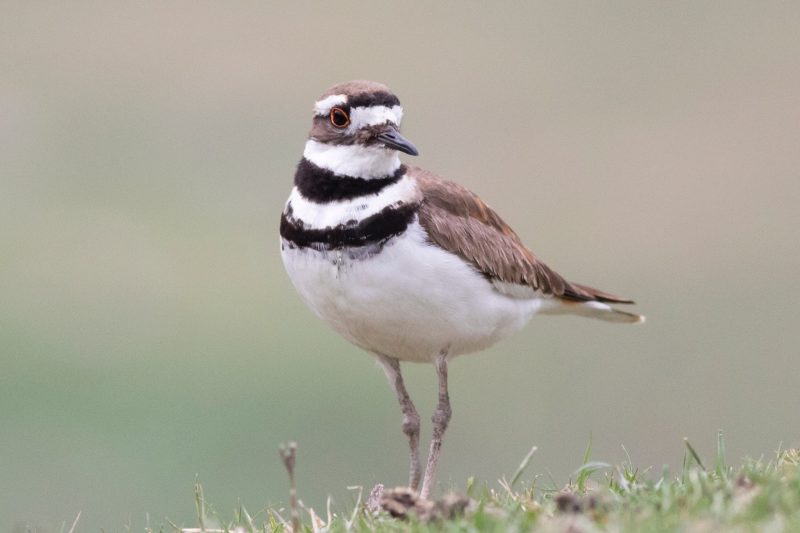
The Killdeer is the largest and most vocal plover species found in Florida. Measuring 8 to 11 inches (20–28 cm) in length with a wingspan of around 18 inches (46 cm) and weighing 3 to 4 ounces (85–115 g), it is easily recognized by its long legs, two bold black breast bands, and bright orange-brown rump visible in flight. Its loud “kill-deer” call—often given in flight or when alarmed—makes it one of the most familiar shorebirds even far from the coast.
Unlike most plovers that stay near the ocean, Killdeer thrive in a wide range of open habitats, including pastures, golf courses, mudflats, and even parking lots. They feed on insects, earthworms, small crustaceans, and other invertebrates, often seen running swiftly across open ground before stopping to probe or pick food items.
Killdeer are year-round residents in Florida, breeding throughout the state from early spring to late summer. They nest on bare gravel or sandy patches, creating shallow scrapes that blend perfectly with the surroundings. Their famous “broken wing” display—pretending to be injured to lure predators away from the nest—is one of the most dramatic examples of bird defense behavior.
This adaptability has helped the Killdeer maintain stable populations across Florida despite urban expansion. You can often find them around freshwater ponds, agricultural fields, and coastal flats, making their loud, piercing calls one of the most recognizable bird sounds in both rural and suburban Florida.
Black-bellied Plover (Pluvialis squatarola)
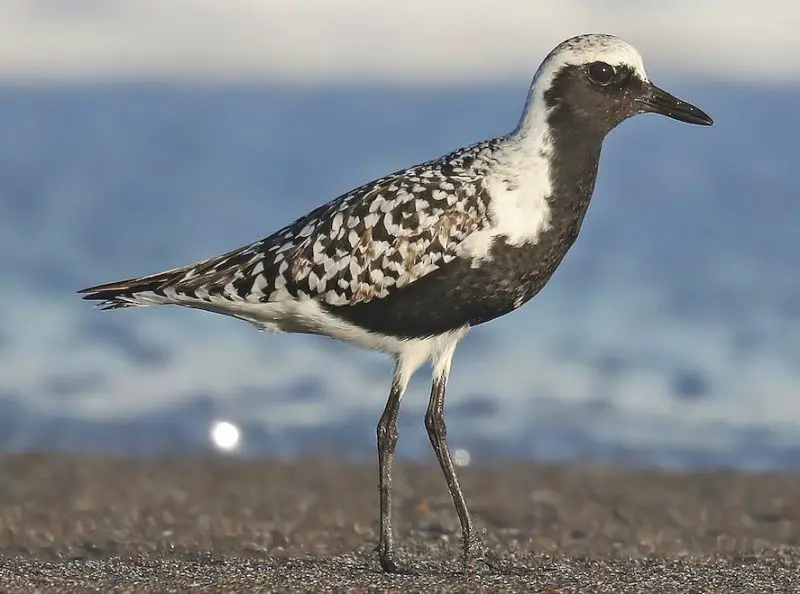
The Black-bellied Plover, also known as the Grey Plover in Europe, is the largest plover species regularly seen in Florida. Adults reach 11 to 12 inches (28–31 cm) in length with a wingspan of 27 to 29 inches (69–74 cm) and weigh 6 to 8 ounces (170–230 g). During the breeding season, males are striking with jet-black faces, throats, and bellies bordered by a brilliant white edge and mottled black-and-white upperparts. In non-breeding plumage, they turn a more subdued gray above and white below, making them blend perfectly into coastal sandflats.
These plovers are long-distance migrants, breeding in the Arctic tundra and wintering across Florida’s coastlines and estuaries. They prefer mudflats, beaches, and shallow lagoons, where they feed mainly on marine worms, crustaceans, and insects. Their foraging style involves standing still and scanning intently before darting forward to seize prey—a methodical and deliberate hunting approach compared to the quick dashes of smaller plovers.
Black-bellied Plovers are cautious birds, often the first to detect danger in mixed shorebird flocks. Their loud, plaintive whistle is a familiar sound along Florida’s winter coasts. They roost in open areas at low tide, often with other shorebirds, and take flight in graceful, synchronized flocks when disturbed.
In Florida, they are most abundant during the winter months (October through March), frequenting sites like Merritt Island National Wildlife Refuge, Tampa Bay, and the Everglades coastline. Watching their transformation from drab gray winter plumage to their stunning black-bellied breeding attire in late spring is one of the delights for birdwatchers along Florida’s shores.
American Golden-Plover (Pluvialis dominica)
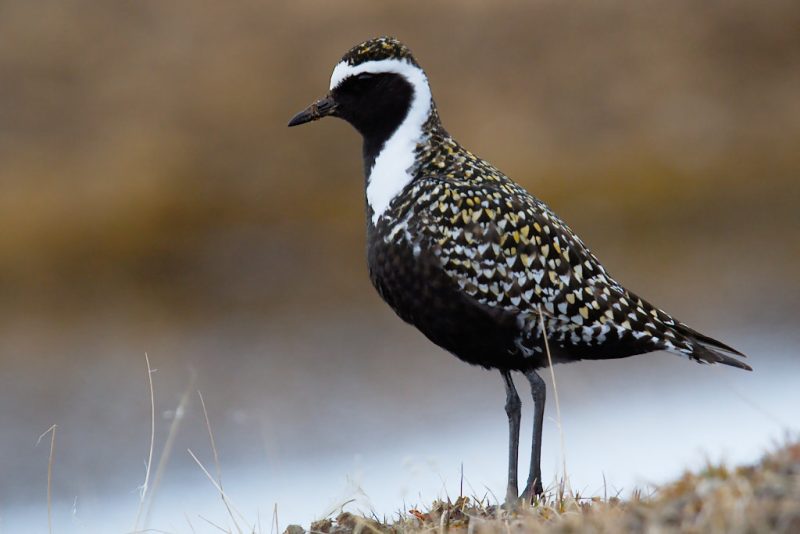
The American Golden-Plover is an elegant, long-distance migrant that occasionally passes through Florida during spring and fall. Measuring 9 to 11 inches (23–28 cm) in length with a wingspan of about 24 inches (61 cm) and weighing around 4 ounces (115 g), this sleek bird is built for endurance. During the breeding season, males are stunning—adorned with a black face, neck, and belly framed by a bright white stripe running from the forehead down the sides of the neck, contrasting sharply with golden-spotted upperparts. In winter, they take on a more subdued mottled gray-brown plumage that provides excellent camouflage.
This plover breeds in the Arctic tundra of North America and undertakes one of the longest migratory journeys of any shorebird, flying up to 20,000 miles round-trip to and from its wintering grounds in South America. In Florida, it is an uncommon migrant, often seen resting on coastal mudflats, flooded fields, and grassy shorelines during its long journey south.
The American Golden-Plover feeds on insects, crustaceans, and marine worms, using a stop-and-go foraging method like other plovers. It is most often spotted during April–May and September–October, especially along the Gulf Coast and in the Panhandle region. Its graceful movements and shimmering golden plumage make it a special sight for lucky birdwatchers during migration season.
Mountain Plover (Charadrius montanus)
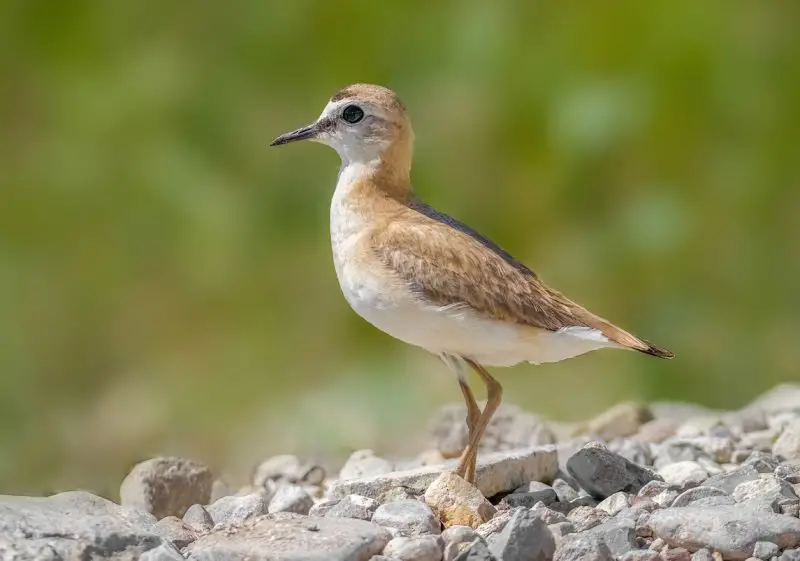
The Mountain Plover is a rare and fascinating visitor to Florida, usually appearing only during migration or winter months. It is a medium-sized plover, measuring 8 to 9.5 inches (20–24 cm) long with a wingspan of 18 inches (46 cm) and weighing about 3.5 ounces (100 g). Unlike most plovers, it lacks a breast band, giving it a plain, buff-colored appearance with a pale face and light brown upperparts that blend seamlessly into dry grassland habitats.
True to its name, this species breeds on high plains and prairies of the western United States, preferring arid, open landscapes rather than coastal beaches. In Florida, it is a very rare vagrant, with occasional records from agricultural fields, dry coastal prairies, or open sandy flats.
Mountain Plovers feed on insects, especially grasshoppers and beetles, using their sharp eyesight to spot prey from a distance. Their foraging behavior is active and efficient, and they are often seen walking briskly rather than running in short bursts.
Because of habitat loss and agricultural development in its breeding range, the Mountain Plover is considered Near Threatened. Spotting one in Florida is a rare treat for birders, usually occurring in open fields during winter, particularly in the Panhandle or central interior regions.
Lesser Sand Plover (Charadrius mongolus)
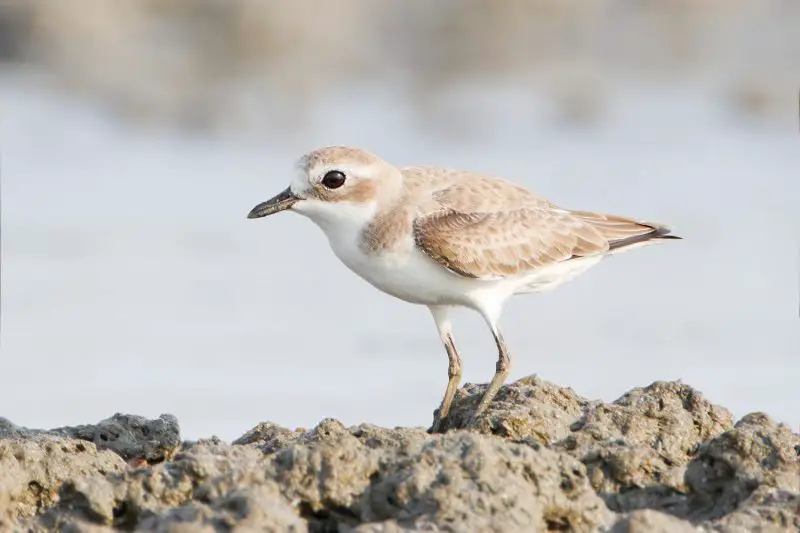
The Lesser Sand Plover is a small, compact bird native to Asia, occasionally recorded as a rare vagrant along Florida’s coasts. Measuring 7 to 8 inches (18–20 cm) long with a wingspan of 15 inches (38 cm) and weighing around 2 ounces (55 g), it resembles the Semipalmated Plover but has a longer bill, shorter tail, and more upright posture. During the breeding season, males develop a rusty-orange breast band and black facial markings, giving them a striking, colorful appearance.
This species breeds across Central Asia and the Himalayas, wintering along the coasts of southern Asia, Australia, and occasionally reaching the Americas. Rare sightings in Florida have occurred mainly in the Florida Keys and along the Atlantic Coast, where individuals mix with other migrating shorebirds.
The Lesser Sand Plover feeds primarily on small crustaceans, mollusks, and marine worms, picking its prey from wet sand and shallow mudflats. Its calm, methodical foraging behavior contrasts with the quick, darting movements of many other plovers.
Seeing a Lesser Sand Plover in Florida is an exceptional event, exciting both local and visiting birdwatchers. It serves as a reminder of the remarkable global movements of shorebirds and how interconnected the world’s coastal ecosystems truly are.
Collared Plover (Charadrius collaris)
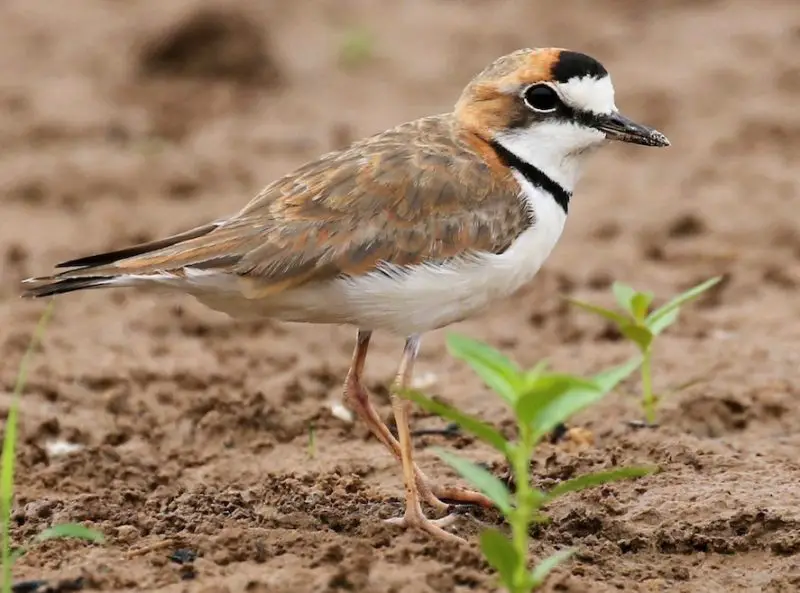
The Collared Plover is another rare but fascinating visitor to Florida, typically found much farther south in Central and South America. Small and dainty, it measures 5.5 to 6 inches (14–15 cm) long, with a wingspan of 12 inches (30 cm) and weighs about 1.3 ounces (37 g). It has a distinctive black neck band (or “collar”), white face, brown upperparts, and a bright orange bill with a black tip. Males appear slightly more vividly marked than females.
This species favors open sandy beaches, riverbanks, and salt flats. Its feeding style is lively and graceful—alternating between quick runs and short pauses as it picks small invertebrates from the sand. Unlike many plovers, it often forages close to water’s edge in both freshwater and coastal environments.
Although not a regular Florida resident, a few Collared Plovers have been recorded along the southern Gulf Coast and the Florida Keys, particularly after strong tropical weather systems that displace birds northward. Such sightings generate considerable excitement among birding communities.
The Collared Plover’s presence in Florida, though rare, highlights the state’s position as a key crossroads for migratory and wandering shorebirds from across the Western Hemisphere. For birders exploring Florida’s southern shores, spotting this elegant species is truly a once-in-a-lifetime experience.
FAQs about Plovers in Florida
What time of year can you see plovers in Florida?
Plovers can be seen in Florida throughout the year, though their abundance varies by season. Resident species like the Wilson’s Plover and Killdeer are present year-round, nesting along coastal and inland areas. Migratory species, such as the Semipalmated Plover, Piping Plover, and Black-bellied Plover, are most common during spring (April–May) and fall (August–October) migrations. Winter months (November–March) also bring large numbers of Black-bellied and Piping Plovers along the Gulf Coast.
Where are the best places to see plovers in Florida?
Some of the best birding spots for plovers in Florida include Fort De Soto Park, Merritt Island National Wildlife Refuge, Anclote Key Preserve, and the Gulf Islands National Seashore. The Florida Keys and Cape Sable are also excellent for observing both resident and migratory plovers. During migration, mudflats, salt marshes, and tidal lagoons attract large flocks of feeding birds, while sandy Gulf beaches are key nesting areas for Snowy and Wilson’s Plovers.
Which plovers are considered threatened in Florida?
Two species are listed as Threatened in Florida: the Snowy Plover (Charadrius nivosus) and the Piping Plover (Charadrius melodus). Both face challenges from habitat loss, human disturbance, and coastal development. Conservation programs such as protected nesting zones, seasonal beach closures, and volunteer monitoring efforts are in place to help safeguard their populations.
How can birdwatchers help protect plovers in Florida?
Birdwatchers can help protect plovers by observing from a distance, avoiding nesting areas, and keeping dogs leashed on beaches. It’s also helpful to respect roped-off zones and warning signs during nesting season (typically March–August). Reporting sightings of rare or banded plovers to local wildlife organizations, such as Audubon Florida or the Florida Fish and Wildlife Conservation Commission (FWC), contributes to valuable conservation data.
What is the difference between a Killdeer and other plovers?
The Killdeer is noticeably larger than most plovers and is one of the few that lives far inland rather than primarily along the coast. It can be recognized by its two bold black breast bands, compared to one on smaller species like the Wilson’s or Semipalmated Plover. It also has a loud, piercing “kill-deer” call and performs a dramatic “broken wing” distraction display to protect its nest—behaviors that make it unique among Florida’s plovers.

